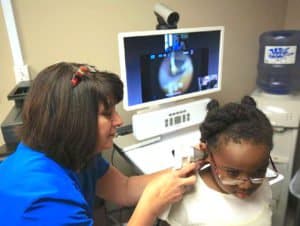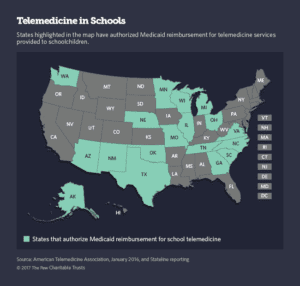For some of the same reasons telemedicine is being welcomed into hospitals, prisons or private practices, we are finding that it’s also gaining popularity with schools. Moving past those general reasons why, here’s what makes telemedicine in schools particularly special:
 Image from ArkansasOnline: Rural Arkansas schools to go telemedicine route
Image from ArkansasOnline: Rural Arkansas schools to go telemedicine route
It keeps kids on campus and in classrooms!
Kids get scrapes, sniffles and sneezes as surely as the sun rises every day and while many schools have an onsite nurse, only some are permitted to independently administer medication. The difference in permission depends on licensure and state certification which Registered Nurses (RN) are given and Licensed Practical Nurses (LPNs) are not. This important detail factors into why Telemedicine in school matters.
(Quick difference between the two types of nurses)
RN: 2-4 year college degree and exam in the state they work. Allowed to perform various medical activities and make decisions about how and when to treat injuries or illnesses.
LPN: High school diploma, nursing program and exam for a license. Their actions must be supervised by an RN or doctor.
According to Deb Group that specializes in occupational skin care and hand hygiene, there are 164 million lost school days per year from students in K-12. Missing school puts students at a disadvantage. Each day that a student misses school means 7.5 hours of catch up in addition to the hours they already have. It’s burdensome and overwhelming, and we haven’t even considered that the day they missed was a test prep day.
So let’s consider the case of an asthmatic child enrolled in a school with LP nurses. The child is wheezing and gasping for air and seeks the nurse for help. The LPN recognizes this as an asthma attack and has access to asthma medication, however laws are preventing the LPN from administering them. The child at this point can be in desperate need with the remedy readily available, but only a doctor or RN is permitted to provide medication.
In this time sensitive situation the LPN is only authorized to call an ambulance and/or the legal guardian and wait. By the time they finally arrive, the condition may have worsened causing the student to lose the rest of the day and maybe another for recovery.
How having Telemedicine helps
If the school had implemented telemedicine, the LPN could have contacted an offsite doctor or RN to show them the child and ask about the appropriate steps to take. Seeing the child, the doctor or RN would then be able to make a diagnosis and authorize the LPN to act on their behalf (while they supervise) and treat the child in-need right then. Telemedicine is not just beneficial to helping kids with asthma. A similar scenario could be played out if it were a stomachache, headache, earache, fever, strep throat – you name it.
This is not to say that secure videoconferencing can end all mid-day visits to the family doctor’s office. Instead this should be seen as a frontline solution that can help treat kids right away – at school, and back in classrooms so they don’t fall behind.
Here are the states that already authorize Medicaid reimbursement for telemedicine services in schools. Does Medicaid offer reimbursements for telemedicine in your state?

